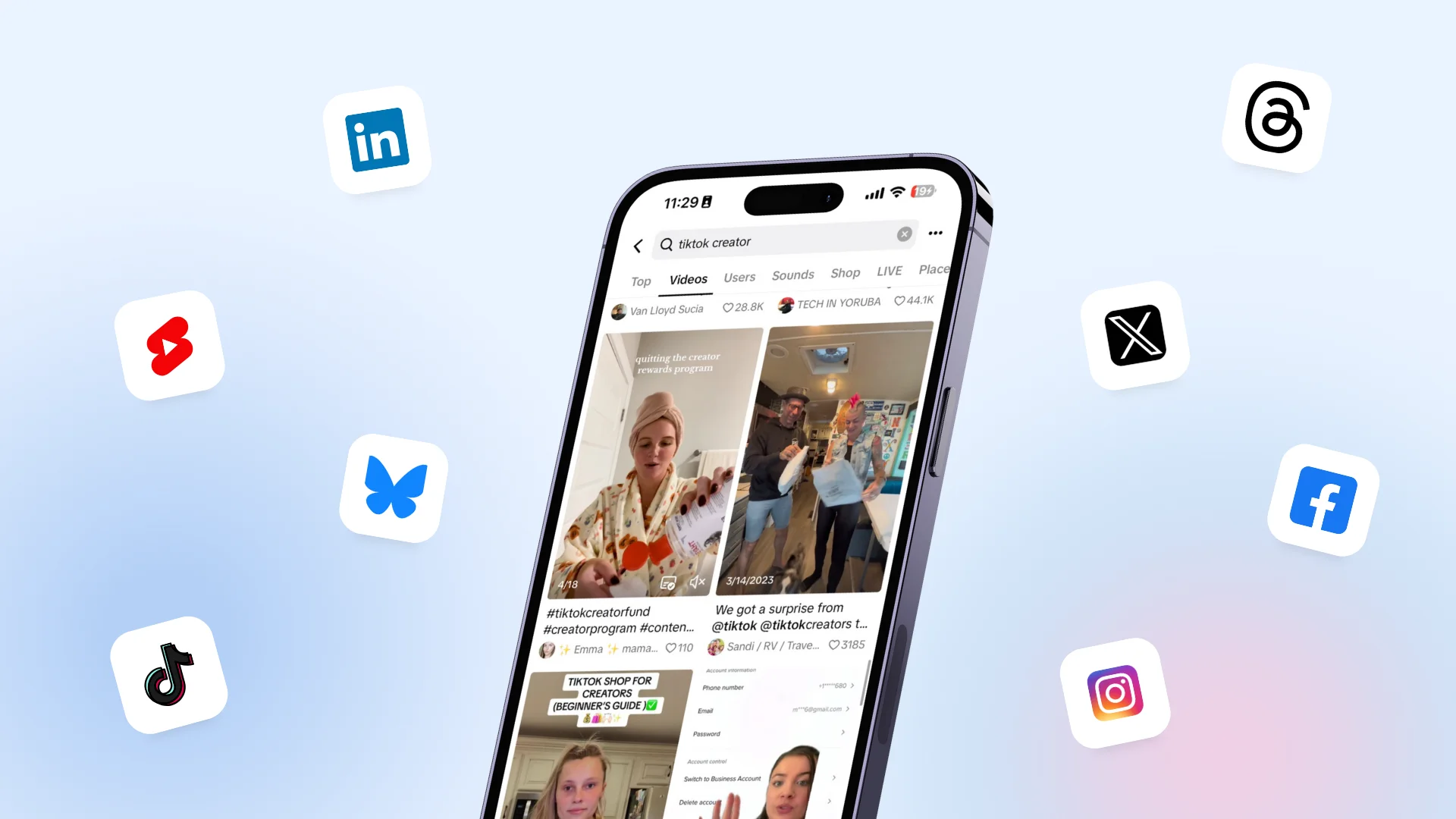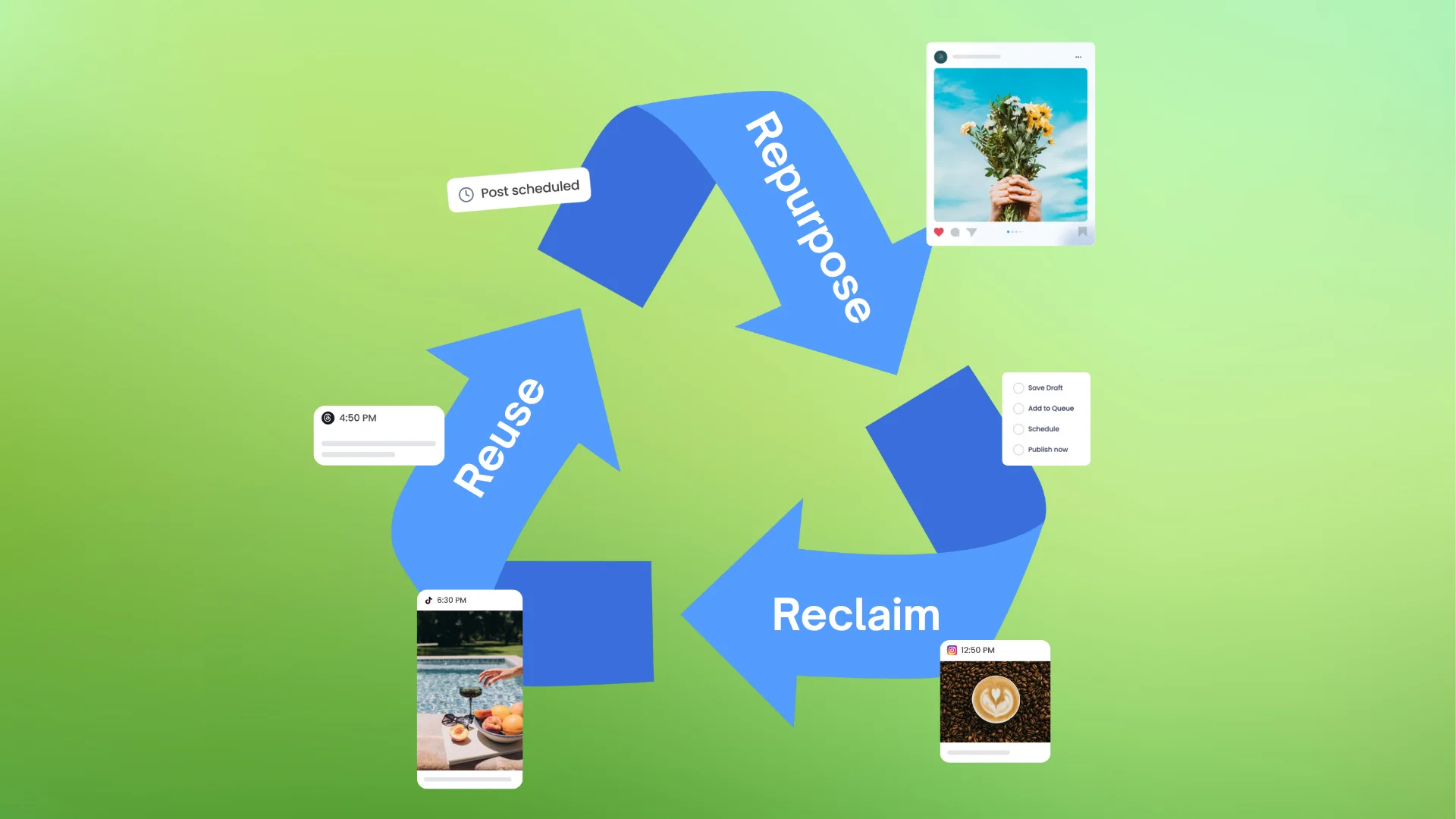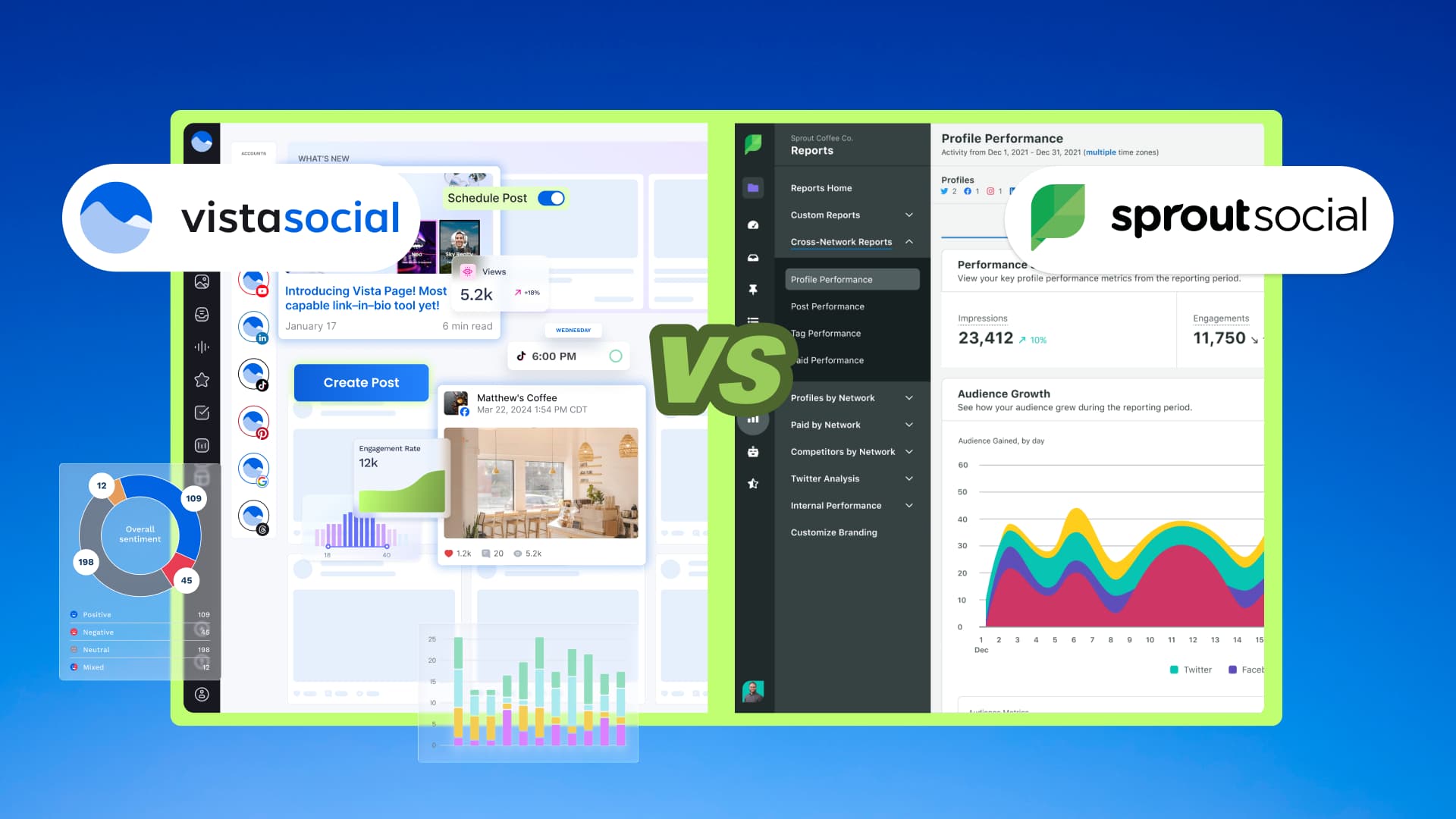New

Turn Your DMs Into Lead Gen!
Learn how to collect lead data from your DMs such as email addresses, phone numbers, and more right from your social inbox. If you are not yet automating your DMs your competitors are outpacing you.

How Something Social Saved 75% of Their Time and Increased Revenue by 15%
See how a fast-growing agency improved operations, cut down hours of manual work, and unlocked new revenue opportunities with Vista Social.
New

50 Unique Social Media Ideas for Consistent Content Creation
Discover 50 unique social media post ideas to engage your audience, grow your brand, and maintain a consistent content strategy with ease!

Mastering Content Reuse: The Key to a Consistent and Sustainable Posting Strategy
Published on October 23, 2025
16 min to read
How to Handle Difficult Client Requests Without Scope Creep
Summarize with AI


Table of Content

“Can you quickly add that to this month’s content?”
“I know we agreed on three posts per week, but could we bump it up to five?”
“Would you mind also managing our email marketing?”
If you’ve run a social media agency for longer than about five minutes, you’ve heard some version of these requests. And you’ve probably said yes to more than a few of them.
That’s how scope creep happens. One small “yes” at a time until you’re delivering twice the work for the same price and wondering why your agency feels so unsustainable.
The tricky part is that you want to be helpful. You want your clients to be happy. You don’t want to seem difficult or inflexible. But constantly saying yes to requests outside your original agreement is a fast track to burnout and resentment.
Throughout this guide, we’re breaking down exactly how to handle difficult client requests professionally, set boundaries without damaging relationships, and keep your projects profitable.
Table of contents
What is scope creep?
Scope creep is when a project gradually (or maybe even not so gradually) expands beyond its original parameters without a corresponding increase in timeline, budget, or resources.
It starts innocently enough.
A client asks for one extra post. Then they want you to respond to DMs. Then they need you to jump on an unexpected call. Then they’re asking you to create graphics for their email newsletter.
Before you know it, you’re doing 40 hours of work on a contract that pays for 20.
Here’s what scope creep looks like in practice:
- You agreed to create 12 Instagram posts per month, but now the client wants daily Instagram Stories
- Your contract includes content creation but not community management, yet you’re spending hours responding to comments
- You’re supposed to manage two platforms but the client keeps asking about TikTok and Pinterest
- You built strategy time into your pricing but now the client wants weekly strategic consulting calls
The problem isn’t that clients ask for more. That’s natural (and hopefully a sign they’re happy with your work). The problem is when agencies consistently say yes without adjusting the overall pricing or scope.
Scope creep doesn’t just hurt your bottom line.
It creates resentment that damages client relationships, makes it impossible to take on new clients because you’re overworked on existing ones, and sets a precedent that’s hard to walk back later.
How does scope creep happen?
Before we talk about how to handle difficult requests, it’s worth understanding why they happen in the first place.
Most of the time, clients aren’t trying to take advantage of you. They’re operating from a different perspective.
Sometimes they genuinely don’t understand what was included in the original scope. If your contract says “social media management” without specifics, they might reasonably assume that includes everything social media-adjacent.
Other times, their business needs have evolved since you started working together.
Maybe they launched a new product and need more promotional content. They hired a new CEO who wants to build a personal brand. Or their target market changed and their strategy needs to shift.
Some clients are testing boundaries to see what they can get. This isn’t always malicious—they just want to maximize value and see where the line is.
And occasionally, you have clients who genuinely don’t respect your time or boundaries. These are the ones you’ll eventually need to part ways with.
All in all, some of the main causes of scope creep include:
- A poorly explained project scope: If you haven’t clearly defined the project scope, it can be extremely easy for the project to expand beyond its original scope, causing you and/or your team to spend more time than initially planned
- Miscommunication: Make sure your team and your client are on the same page about the project so no miscommunication can cause additional tasks to be added onto the project
- Unclear or unrealistic project objectives: If you don’t have clearly set objectives or goals for the project, or the ones you’ve set simply aren’t realistic in the time frame, your team can find themselves working overtime to try to deliver
- Too many cooks in the kitchen: If your client has five different points of contact who are all sending in individual requests, the scope is naturally going to be thrown off; instead, ask your client to name a single person that communicates with your agency
- Too many requests for revisions: Set clear guidelines for how many edits clients can request, otherwise your team may end up recreating and recreating social media posts and spending way too much time on a single client
Understanding the “why” behind requests helps you respond more effectively.
A client who’s confused about scope needs education. A client whose needs have changed might need an upsell. A client testing boundaries needs firm but friendly pushback.
How to avoid scope creep
If you can, avoiding scope creep is the ideal situation for everyone. Then your team doesn’t have to worry about projects getting out of control and your clients are happy with what you’re doing for them.
Aim to avoid scope creep altogether with these tactics.
Set yourself up for success
Like we said, the best way to handle scope creep is to prevent it from happening in the first place. That starts with how you structure your client agreements.
Your contract needs to be crystal clear about what’s included and what’s not. Don’t just say “social media management.”
Spell out exactly what your clients are getting, like:
- The number of social media posts per week
- Which platforms you’re posting to
- Whether graphics are included
- If you’re handling community management
- What the revision process looks like
- How often you’ll meet
It may even be a good idea to include a section that explicitly outlines what’s not included in your services. This might feel awkward, but it can prevent misunderstandings later.
For example, you might note that paid advertising management, email marketing, website updates, and graphic design beyond social media posts are separate services.
In addition, you’ll also want to build in a clear change request process. Your contract should explain that any requests beyond the original scope will require a separate quote and written approval before work begins.
Make sure to set communication boundaries from day one. Establish when and how clients can reach you, how quickly you’ll respond, and what your meeting cadence looks like. If clients know they have a weekly check-in, they’re less likely to request constant ad-hoc calls.
During client onboarding, walk through the contract together. Don’t just send it and hope they read it. Actually discuss what’s included, answer questions, and make sure you’re aligned to head off future confusion.
Use your social media management platform to make scope visible. When clients can see the content calendar and what’s scheduled, they have a clearer picture of what you’re delivering.
With Vista Social, this is easy. You can create logins for your clients so they’re able to check in on the content calendar and even provide feedback on different posts, all within the same tool.

Create a plan for handling out-of-scope requests
Even with perfect contracts and boundaries, clients will still make requests outside your original agreement. Here’s how to handle them without damaging the relationship.
Start by acknowledging the request positively. Never make clients feel bad for asking. Say something like “Thanks for bringing this up,” or “I appreciate you thinking of me for this.”
Then clarify whether the request is within scope. Sometimes what seems like an extra ask is actually covered by your agreement. If it is, great—let them know you’ll take care of it. If it’s not, that’s when you need to address it.
Explain why it’s outside the scope using your contract as reference. You might say “I’d love to help with this! Looking at our agreement, we’re currently set up for 12 feed posts per month on Instagram. Adding daily Stories would be an expansion of our scope.”
Offer options for how to move forward. This is where you maintain the helpful, solution-oriented approach while protecting your boundaries.
You could offer options like:
- Add the request as an additional service for an extra fee
- Swapping the new task for something currently in scope
- Revisiting the entire package to build in more services
Get everything in writing before proceeding. If the client agrees to pay extra for the additional work, send a brief amendment to your contract or at minimum a detailed email outlining what’s being added and at what cost.
Here’s what this looks like in a real conversation.
Let’s say a client emails asking you to also start managing their LinkedIn company page when you’re currently only handling Instagram.
Your response might be something like:
“Thanks for reaching out about LinkedIn! I think it could be a great platform for you. Looking at our current agreement, we’re focused on Instagram right now—that’s 12 posts per month plus Stories and engagement. Adding LinkedIn would mean creating an additional 8-12 posts tailored to that platform, plus optimizing your company page. I’d love to take this on! I can put together a proposal for adding LinkedIn to your package. Would you like to schedule a quick call to discuss what that might look like?”
Notice how this response is friendly and helpful while clearly drawing a boundary. You’re not saying no—you’re saying yes with appropriate compensation.
Scripts to use for common difficult requests
Of course, you naturally want to do whatever you can to make your clients happy. But it’s important to make sure you’re getting fairly compensated at the same time.
Let’s walk through some specific client scenarios to give you an idea of how to respond.
When a client asks for more content than your agreement includes:
“I’d be happy to increase your posting frequency! Right now we’re delivering 12 posts per month based on our current package. Moving to 20 posts per month would mean additional content creation time. I can create an updated proposal for the higher frequency—typically that tier runs $X per month. Does that work with your budget?”
When a client wants you to manage additional platforms:
“I love that you’re thinking about expanding to TikTok! That’s outside our current scope where we’re focused on Instagram and Facebook. I can definitely help you with TikTok strategy and content. Let me put together some options for adding that platform—it would typically involve X hours per week for content creation and posting. Want me to send over some package options?”
When a client requests urgent or rush work:
“I can absolutely prioritize this for you. For rush requests that need to jump the line ahead of scheduled work, I do charge a 25% rush fee to accommodate the expedited timeline. Would you like me to proceed with that, or would it work to include this in next week’s regular content batch?”
When a client wants to add services you don’t offer:
“That’s not something I specialize in, but I’d hate for you not to get help with this. Can I connect you with [type of service provider] who would be perfect for this? I want to make sure you’re working with someone who can really knock this out of the park for you.”
When a client wants more of your time through extra meetings or calls:
“I’m glad you’re finding our check-ins valuable! Our current package includes bi-weekly 30-minute calls. If you’d like to move to weekly calls or extend to 60 minutes, I can adjust the package to reflect that additional time. What works better for your schedule and budget?”
The pattern here is acknowledge, clarify scope, offer a solution, and ask for buy-in. This keeps the conversation collaborative rather than confrontational.
Know when to say yes to out-of-scope requests
Here’s the thing—you don’t have to say no to every single request that falls outside your original agreement. Sometimes saying yes is the right business decision, even if it means doing a bit of extra work without compensation.
Try Vista Social for Free
A social media management platform that actually helps you grow with easy-to-use content planning, scheduling, engagement and analytics tools.
Get Started NowHere are a few instances where it might make sense to say yes:
- The request is truly small and infrequent. If a great client asks you to create one extra post for a special announcement and they never ask for extras otherwise, just do it. The goodwill is worth more than that single hour of work.
- It’s a chance to demonstrate additional value you could upsell later. If a client asks about TikTok and you create one test video for free, you might prove the value and land an expanded contract.
- The client is in crisis mode and needs genuine help. If their event got rescheduled last-minute and they need you to update several posts quickly, being the agency that shows up in clutch moments builds incredible loyalty.
- The request helps you learn a new skill you want to develop anyway. If you’ve been wanting to experiment with LinkedIn newsletters and a client asks about it, this could be a win-win.
- Saying no would damage an otherwise fantastic client relationship over something minor. Pick your battles. Not every hill is worth dying on.
The key is being intentional about when you say yes. Make it a conscious choice, not a default response driven by fear of confrontation or losing the client.
Know how to handle clients who consistently push boundaries
Some clients will test every boundary you set. No matter how clearly you communicate, they keep asking for more.
First, make sure you’re not contributing to the problem. If you said yes to out-of-scope requests early in the relationship, you trained the client to keep asking. You need to reset expectations clearly.
Schedule a conversation specifically to address the pattern. Don’t try to handle this via email or in passing.
Say something like: “I wanted to touch base about our working relationship. I’ve noticed we’ve had several requests lately that fall outside our original agreement, and I want to make sure we’re aligned on scope going forward.”
In that conversation, reference your original contract and point out specific examples. Not in an accusatory way, but factually. Walk through what was agreed upon and where the requests have expanded beyond that.
Offer two clear paths forward: Either return to the original scope as written, or discuss a new agreement that reflects the expanded needs at an appropriate price point.
If the client pushes back or continues boundary-testing even after this conversation, you have a decision to make. Is this client worth the hassle? Are they profitable enough to justify the extra management? Do they refer enough other business that makes it worthwhile?
Sometimes the answer is yes, and you accept that this client requires more management. Other times, the answer is no, and you need to part ways.
Don’t be afraid to fire bad-fit clients. An overly demanding client who doesn’t respect boundaries costs you more than just their billable hours. They cost you energy, opportunity, and mental health.
Raise your rates instead of adding scope
One alternative to constantly expanding what you deliver is to raise your rates as clients ask for more.
When a client makes repeated requests that individually seem small but collectively add up, it’s time for a pricing conversation.
You might say:
“I’ve loved working with you over the past six months, and I’m glad our partnership has evolved. As we’ve added Stories, Reels, more responsive comment management, and monthly strategy calls beyond our original agreement, the time investment has grown significantly. I’d like to propose we formalize these additions with an updated agreement that reflects the full scope of what we’re now delivering. Based on current market rates and the work involved, here’s what that would look like.”
This is different from scope creep because you’re actively choosing to expand services and adjusting pricing accordingly.
Most reasonable clients understand that if they want more, it costs more. The ones who expect constant expansion without fair compensation aren’t clients you want long-term anyway.
Make rate increases or scope adjustments part of your annual review process with clients. Every year, sit down and assess whether your agreement still reflects reality. If scope has crept, address it. If your rates are outdated, adjust them.
Use your contract to protect against scope creep
Your contract is your best defense against scope creep, but only if you actually use it.
Reference your contract regularly in client communications. When questions about scope come up, point back to the specific section that addresses it. This isn’t rude—it’s professional.
Keep your contract accessible. Don’t just file it away after signing. Make sure both you and your client can easily reference it when needed.
Update your contract template based on lessons learned. Every time you encounter a new type of scope creep, add clarity to your contract to prevent it with future clients.
Consider adding a not-to-exceed clause for hourly elements. If your contract includes some flexible hourly work, cap it. Otherwise “a few hours of consulting per month” can easily balloon into 15 hours you’re not getting paid for.
Include a clause about last minute requests and what constitutes “rush.” Define your standard turnaround times and what happens if a client needs something faster.
Specify your revision policy clearly. How many rounds of revisions are included? What constitutes a revision versus a completely new request? Get specific.
The more detailed your contract, the easier it is to point to when boundaries are tested.
Teach clients to respect your boundaries
Your clients will treat you the way you teach them to treat you.
If you respond to emails at 11 PM, they’ll expect that. If you take calls on weekends, they’ll think that’s normal. If you say yes to every request, they’ll keep asking.
Start every client relationship by clearly communicating your boundaries and then consistently enforcing them.
Set email response time expectations and stick to them. If you say you respond within 24 business hours, don’t respond in 10 minutes. You’re training them that your stated policy doesn’t mean anything.
If you don’t work weekends, don’t respond to weekend messages until Monday. Use email scheduling tools if you’re working weekends but don’t want clients to know it.
When clients ask for meetings outside your stated availability, redirect them to your calendar link rather than making exceptions.
Say no sometimes even when you theoretically could say yes. This reinforces that your boundaries are real, not flexible guidelines.
The first few times you hold a boundary, it might feel uncomfortable. Clients might push back. But in the long run, they’ll respect you more for it, and you’ll have a much healthier working relationship.
Communicate clearly
A huge percentage of scope creep happens because of miscommunication or assumptions.
Be proactive about communicating what you’re working on and why. When clients understand your process and see that you’re already at full capacity with their contracted work, they’re less likely to make additional asks.
You can bring tools like Vista Social into this workflow. Giving clients visibility into your content calendar helps them understand what you’re already delivering.
Send regular updates about what you’ve completed and what’s coming next. A simple weekly email saying, “This week I published X posts, responded to Y comments, and scheduled Z content for next week,” keeps clients informed and satisfied.
Over-communicate when you’re at capacity. If you’re slammed and a client makes a new request, don’t just say you can’t do it. Explain that you’re currently at full capacity with their existing scope plus your other client commitments, which is why you’d need to adjust timeline or scope to accommodate the addition.
Ask clarifying questions when requests come in. Sometimes what seems like a massive new request is actually the client describing something already in scope but using different language. Confirm what they’re actually asking for before responding.
Schedule regular strategy check-ins where you review what’s working and what the client would like to see change. This gives you a structured place to discuss potential scope changes rather than having them come up randomly throughout the month.
Build confidence to push back on clients
If you’re struggling to hold boundaries with clients, you’re not alone. Many agency owners feel uncomfortable saying no or asking for more money.
Here’s what helps. Remember that you’re not being difficult—you’re being professional. Contractors in other industries don’t let clients constantly change plans without change orders. You shouldn’t either.
Recognize that clients respect agencies who respect themselves. Pushovers don’t inspire confidence. Professionals who know their worth and protect their boundaries do.
Practice your responses. Role-play difficult conversations with a friend or coach. Write out scripts ahead of time. The more you practice, the easier it gets.
Remember that the worst thing a client can do is say no or leave. And honestly, a client who won’t pay fair rates for fair work isn’t a client you want anyway.
Focus on the long-term sustainability of your business. Saying yes to everything might keep this one client happy in the short term, but it’s destroying your business margins and burning you out. That’s not sustainable.
Connect with other agency owners who understand these challenges. Join communities, find a mastermind group, or work with a coach. When you hear that others struggle with the same issues and successfully hold boundaries, it becomes easier.
Start small. If you’ve been saying yes to everything, you don’t need to suddenly become rigid. Just practice saying no or telling one client something is outside of your scope this week. Build from there.
How to fix scope creep
Maybe you’re reading this thinking, “Too late, I’m already doing twice the work I’m being paid for.”
You can fix this, but it requires an honest conversation with your client.
Start by documenting everything you’re currently doing for the client. List out every deliverable, every hour spent, every service you’re providing. Get really specific.
Then compare that to your original contract. Where are the gaps? What are you doing that was never agreed upon?
Calculate what the expanded scope should actually cost based on your current rates. This gives you a number to work with.
Schedule a call with your client or write out a professional email to address it. Be direct but not confrontational.
You might say something like:
“I want to talk about our current working relationship because I want to make sure it’s sustainable long-term. When we started working together six months ago, our agreement covered X, Y, and Z. Over time, we’ve naturally expanded to also include A, B, C, and D, which is great—it means the relationship is evolving. But I need to adjust our agreement to reflect this expanded scope.”
Present your findings and propose an updated agreement at a fair price. Give them options to either continue at the new rate with expanded scope, or return to the original scope at the original price.
Be prepared for them to be surprised. Many clients genuinely don’t realize they’ve been asking for significantly more than they’re paying for. When you lay it out clearly, most reasonable people understand.
Some clients will push back. They’ll say they thought it was all included, or that other agencies do more for less. Stand firm. Explain that you want to continue working together, but it needs to be at rates that make the relationship sustainable.
If they won’t agree to fair compensation, you need to be willing to walk away or scale back to the original scope. This is hard, but it’s necessary.
Don’t let scope creep impact your social media agency
Handling difficult client requests and preventing scope creep is one of the most important skills you can develop as an agency owner.
It’s what separates profitable agencies from struggling ones. It’s what prevents burnout. It’s what allows you to deliver exceptional work without sacrificing your business or sanity.
Start by getting crystal clear on what you’re actually selling. Make your contracts specific. Set boundaries from day one. Respond to out-of-scope requests professionally but firmly. Don’t be afraid to have pricing conversations. Fire clients who refuse to respect boundaries.
And remember—clients don’t respect agencies who don’t respect themselves. When you hold professional boundaries, you build stronger, more sustainable client relationships.
You can be helpful and keep boundaries at the same time. In fact, that’s exactly the combination that builds a thriving agency.
About the Author
Content Writer
Chloe West is a content marketing manager for Vista Social. She has over seven years of experience in digital marketing for B2B SaaS companies. When she's not working, you'll find her spending time with her family, reading a book, or watering her plants.
Read with AI
Save time reading this article using your favorite AI tool
Summarize with AI
Never Miss a Trend
Our newsletter is packed with the hottest posts and latest news in social media.

You have many things to do.
Let us help you with social media.
Use our free plan to build momentum for your social media presence.
Or skip ahead and try our paid plan to scale your social media efforts.
P.S. It will be a piece of cake 🍰 with Vista Social
Subscribe to our Newsletter!
To stay updated on the latest and greatest Social Media news. We promise not to spam you!


